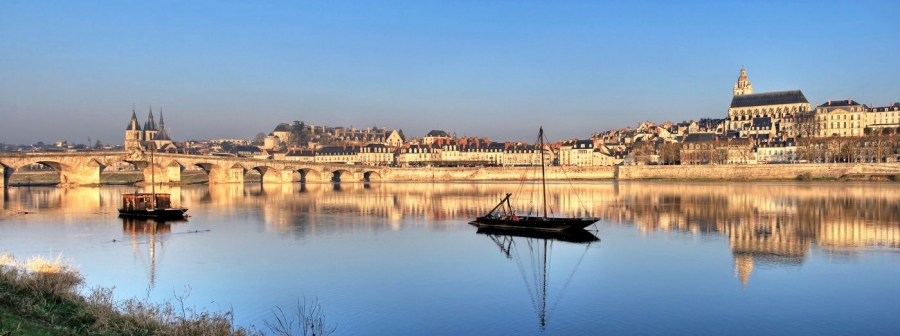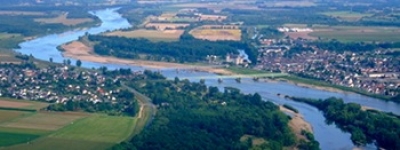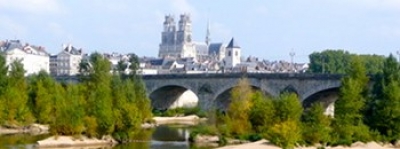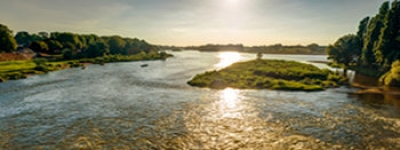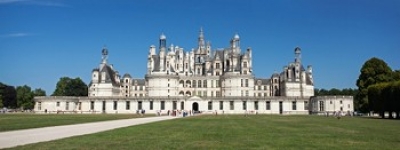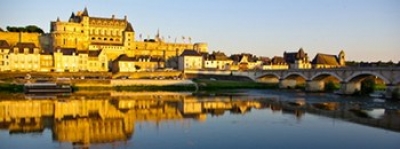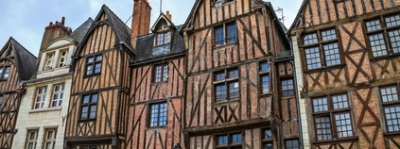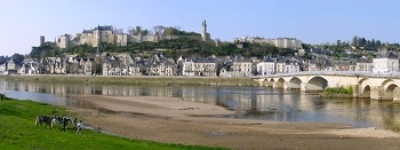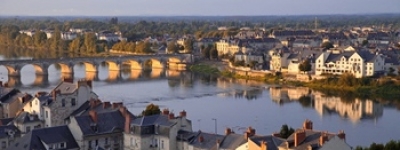World Heritage
Covering 800 km2, the Loire Valley is classified on the list of UNESCO World Heritage sites as a living cultural landscape since 2000. At about 280 kilometers long, from Sully-sur-Loire in the Centre region to Chalonnes-sur-Loire in the Pays de la Loire region, the classified site crosses two French regions and four departments.
The classification of the Loire Valley was a prestigious recognition for the river and its history, its architectural and cultural heritage, its natural landscapes and its strong ties that unite the communities living in the the valley. But beyond recognition, the UNESCO classification presented a challenge for preserving the fragile harmonious balance between man and nature.
A stay in the Loire Valley is primarily a rendezvous with nature, untamed along the currents of the river, along its banks or on its islands, and tamed at the heart of its many gardens, sometimes prestigious but always beautiful.
A stay in the Loire Valley is also a historical voyage, whether visiting the medieval and Renaissance castles or the religious heritage and its ancient abbeys. Two thousand years of history have shaped the historical, cultural, religious, military and civilian heritage of the valley.
A stay in the Loire Valley is also the discovery of terroirs and vineyards that dot the banks of the Royal River.
The borders of the World Heritage Site include the Loire River at its center, with its banks and hillsides above. In places where the Loire passes through the communities, the historical center of the city is included in the classified area. Here and there, extensions include certain tributaries of the Loire, allowing castles or religious buildings to be included in the Loire Valley site.
Criteria for selection
Criterion (i): The Loire Valley is noteworthy for the quality of its architectural heritage, in its historic towns such as Blois, Chinon, Orléans, Saumur, and Tours, but in particular in its world-famous castles, such as the Château de Chambord.
Criterion (ii): The Loire Valley is an outstanding cultural landscape along a major river which bears witness to an interchange of human values and to a harmonious development of interactions between human beings and their environment over two millennia.
Criterion (iv): The landscape of the Loire Valley, and more particularly its many cultural monuments, illustrate to an exceptional degree the ideals of the Renaissance and the Age of the Enlightenment on western European thought and design.
Source Unesco / ICOMOS
History
History of the Loire Valley
The history of this cultural landscape began in Roman times. The Loire was already one of the major lines of communication and trade in Gaul. The legacy of this era is reflected in the organization of sites, the urban forms and the communication network.
The history of the Loire Valley was marked starting from the 4th century by Saint Martin, Bishop of Tours, who founded an abbey in Marmoutier. This building would be later used as a model for many monastic buildings in the valley. The religious heritage of the area is so dense because the sanctuary of Tours was one of the most important pilgrimage centers in Europe, before that of Saint-Jacques de Compostela gained the prominence that it has today.
Without the importance of these religious sites, the history of the valley would probably not have been the same. The many monasteries that occupied the valley during the first millennium would incite the establishment of communities and their surrounding villages. From the 10th century onward, local lords erected medieval fortresses, which in turn influenced the establishment of new communities in their immediate vicinity, strongly marking the landscape.
But the history of the Loire Valley was not without turmoil : the valley is at the heart of the Hundred Years War. This conflict forced the king to frequent stays in Tours. Once the war ended (15th century), it was here that the humanistic spirit of the Renaissance took off in France. The appearance of the medieval fortresses would change, transforming these austere mansions into magnificent castles of elegance and exceptional refinement, dedicated to pleasure and entertainment, defining the Renaissance style.
During the 17th and 18th centuries, the economic growth of the valley developed thanks to the Loire, as industrial, artisan and commercial activities were bolstered by the river. This trade and river traffic would make the Loire the most important communication network in France.
After the arrival of the railroad in the 19th century, the economic importance of the river faded. It would then be neglected, and finally rediscovered, seen in a new light by becoming a place of leisure of outstanding natural wealth.
The cultural landscapes
The cultural landscapes of Loire Valley
The selection of this area for the World Heritage List of UNESCO recognized the universal value of the Loire cultural landscape in its authenticity and integrity. Its loss would be considered irreplaceable for the collective memory of humanity.
The Loire is considered the last untamed river in Europe because it has never been channeled. And although it has many exceptional natural sites, it is indeed a cultural landscape that has been shaped by man for over 2000 years. Whether agrarian landscapes or buildings, these fit perfectly into the natural environment that surrounds them.
Historically, the communication channels, which had existed since Antiquity, led to the establishment of the first settlements. These Roman roads followed the ridgeline of the right bank of the river. Successively, Benedictine abbeys and local lords structured the landscapes of the Loire Valley. The castles and the gardens bequeathed by the greatest royal dynasties (Plantagenet, Capet, Valois ... ) resonate like jewels that made the Loire Valley renown the world over.
These diverse historical influences led to the definition of the Loire landscape: a harmony between the river, stone, vines and garden.
Though men have largely shaped the landscape, the Loire River has also influenced the lifestyle of the inhabitants of the valley. It is this thousand-year interaction that has shaped the cultural landscape of the Loire Valley.
This landscape is the expression of a natural complexity, patiently woven over time, that now belongs to all those who inhabit the Loire Valley, and it is for them to understand, maintain and preserve for the better for future generations.
Composition of the Loire landscape
The Loire has always been built transporting people and goods, as well as for flood prevention, as evidenced by the 600 kilometers of levees (dikes) and wharfs, witnesses to the economic activity of the river. The many natural habitats distributed along the river make it an essential area for European biodiversity. The banks of the river are home to floodplains and particularly fertile agricultural fields.
Human communities were established near the river crossing (fords, then bridges) on high vantage points that allowed them protection from floods. Towns and cities were developed around the churches and the harbors. This ensemble makes up the "building front."
Discovering the Loire landscape
To get to the heart of the Loire landscape, it’s necessary to go from castles to abbeys, from great historic cities to charming villages where all the stones of the Loire color the landscape in white limestone and black slate. The river and its banks offer an opportunity to encounter a rich flora and varied fauna. And even when tamed, the surrounding nature expresses its beauty in the old, grand and intimate gardens, Renaissance castles and medieval abbeys. It is here that French gardens were first born. This expressive nature participates in its own way to the beauty of the Loire landscape.
Remarkable and protected animal species
Many protected species live around the river. When walking or biking along the river, respect for all inhabiting species is essential. Considered as a migration corridor, the Loire hosts migratory birds (terns, little ringed plovers) that use the sand islands for a long break in their journey. Some of these islands are now protected so as not to interfere with their reproduction, or damage plants.
Wine of Loire Valley
Like the gardens of the Loire Valley, its vineyards and wine are also an expression of its cultural landscape. Several prestigious appellations are recognized from this region: Chinon, Bourgueil, Saumur, Touraine ... wines that ripen in troglodyte caves.
Navigation on the Loire
Navigation
JUntil the 19th century, navigation of the Loire was possible with the flow of the river’s current (upstream to downstream), and in the reverse direction, it was necessary to use sails to go back up the river (downstream to upstream). In the absence of wind, the boats were towed by men (most frequently) or horses (less often) from the towpath, often located on the levees. For a boat, 3 or 4 men was enough, but a train of boats could require up to 40 haulers in orderly rows.
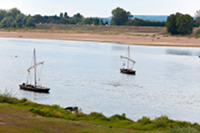
Boats
Many types of boats were used for sailing on the Loire, but all were flat bottom, the “sapines” being the most common. Built in pine (“sapin” in French), they did not last longer than a trip, however. Barges were built out of oak and lasted longer. The “futreaux” resembled flat-bottomed barges, but were smaller.
The amount of freight carried on each boat depended on river water level. The river carried everything necessary for the construction of cities and castles, as well as the daily life of the inhabitants of the valley.
Milestones of the Loire
The Loire river milestones are blocks of white stone laid along the banks of the Loire. They were installed in the mid-19th century.
Several types of milestones dot the river :
Square milestones are located on the banks or levees, located about every kilometer. They are engraved with a number followed by a letter, "M" for upstream and "D" for downstream. The numbering begins at the Paris Meridian.
Cylindrical milestones :
North of the Loire, the number each shows indicates the distance in kilometers covered by the Loire from the east to the west of the department.
South of the Loire, the milestones have continuous numbering, indicating the distance (in kilometers) of navigable river left to cover.
The girouet
The girouet was the instrument of navigation and decoration that was found at the top of the masts of the boats of Loire. Painted and carved with a knife in a wooden board at the vigil, this weather vane was highlighted by a colored banner identifying each boatswain.
Built with quality materials (slate, natural stone) and more contemporary ones (stainless steel), the girouet features the identity of each municipality on its central panel.
Bicylce Itinerary
The Loire à Vélo bicycle itinerary
The Loire à Vélo bicycle itinerary was a monumental project whose goal was to connect all of the regions along the Loire, listed as World Heritage sites by UNESCO. Now completed, the route extends over 800 kilometers of bike paths, of which 280 kilometers are included within the classified site. It is composed of bike paths alternating with regional roads. Carefully studied, the route allows cyclists to move at their own pace, passing the major tourist attractions of the Loire Valley (castles, gardens, vineyards, banks of the Loire ... ). This innovative ecotourism initiative is a unique and original way to discover the wonders of the Loire’s landscapes.
Everything was been designed for the comfort and convenience of visiting cyclists, from the specialized accommodation network, "Accueil Vélo" (Bike Hosts), to approved bicycle rental and repair centers.
All information is available on the website : www.cycling-loire.com
Additional Information
The Loire à Vélo itinerary also connects to the EuroVelo 6 route, called Eurovéloroute of the rivers, a bicycle route that connects the Atlantic coast to the Black Sea, along the rivers Loire, Rhine and Danube, through 10 countries along 3,650 kilometers : www.eurovelo6.org
Bike + Train
SNCF offers a website dedicated to visitors traveling with their bikes.

